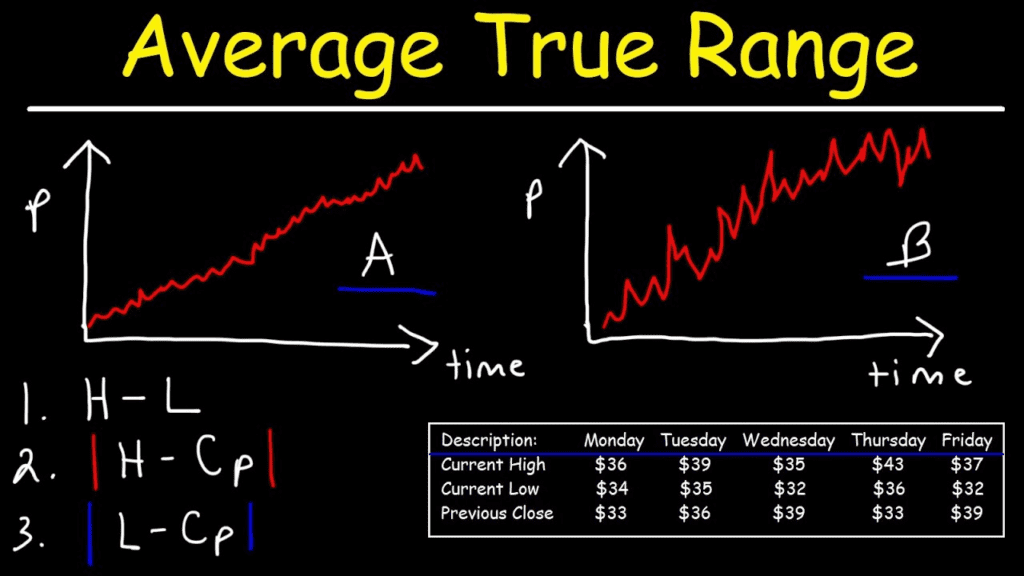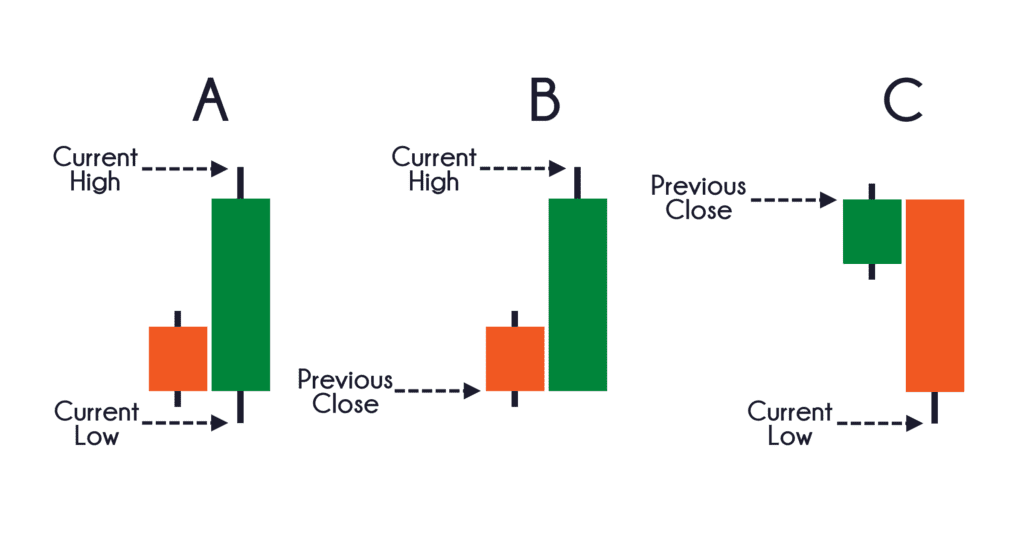What Is Average True Range?

Average True Range (ATR) is a technical analysis indicator used to measure the volatility or the degree of price movement in a financial instrument, such as stocks, commodities, or currencies, over a specific period of time. It was developed by J. Welles Wilder and introduced in his book “New Concepts in Technical Trading Systems.”
The ATR calculates the average range between the high and low prices of an asset over a given number of periods. It considers any gaps between consecutive periods and incorporates these into the calculation. The ATR is typically presented as a value or a percentage of the asset’s current price.
Traders and analysts use the ATR to gain insights into the potential volatility and range of price movement for an asset. A higher ATR value suggests greater volatility, while a lower ATR value indicates lower volatility. Traders may use the ATR to determine stop-loss levels, set profit targets, or identify potential breakout points.
To calculate the ATR, the following steps are generally followed:
- Calculate the true range (ATR) for each period. The true range is the greatest of the following three values:
- The difference between the current period’s high and low prices.
- The absolute value of the difference between the current period’s high and the previous period’s close.
- The absolute value of the difference between the current period’s low and the previous period’s close.
- Determine the average true range (ATR) over the desired number of periods by calculating the moving average of the true range values. Typically, a 14-day period is commonly used, but this can be adjusted based on the trader’s preference or the characteristics of the asset being analyzed.
The ATR is a useful tool for assessing volatility and making informed trading decisions. However, it should be used in conjunction with other technical indicators and fundamental analysis to form a comprehensive trading strategy.
Importance of ATR

The Average True Range (ATR) is an important tool for traders and analysts due to its several key benefits and applications:
- Volatility Measurement: ATR provides a reliable measure of price volatility. By understanding the level of volatility in an asset, traders can adjust their trading strategies accordingly. High ATR values indicate higher volatility, suggesting larger price swings and potentially increased risk. Conversely, low ATR values indicate lower volatility, implying more stable price movements.
- Stop Loss Placement: ATR helps traders determine appropriate stop-loss levels for their trades. By setting stop-loss orders based on the ATR, traders can account for the natural fluctuations in price and avoid being prematurely stopped out by minor price movements. Wider stop-loss levels can be set for assets with higher ATR, while tighter levels can be used for low-volatility assets.
- Position Sizing: ATR can assist traders in determining the appropriate position size for their trades. By considering the ATR value, traders can adjust their position sizes based on their risk tolerance and the level of volatility in the market. Higher ATR values may warrant smaller position sizes to limit potential losses, while lower ATR values may allow for larger position sizes.
- Trend Identification: ATR can be used to identify periods of increasing or decreasing volatility, which can be indicative of changes in market trends. A rising ATR may suggest a strengthening trend or an upcoming breakout, while a declining ATR may indicate a weakening trend or a period of consolidation. Traders can use this information to make informed decisions about entering or exiting positions.
- Breakout Strategies: ATR is often employed in breakout trading strategies. Breakouts occur when prices move beyond established support or resistance levels. Traders can use the ATR to set appropriate entry points for breakout trades. By incorporating the ATR into their strategies, traders can adjust their entry levels based on the current volatility, potentially improving their chances of capturing significant price moves.
How To Calculate ATR?

The Average True Range (ATR) is calculated using the following steps:
- Calculate the True Range (TR) for each period:
- TR = max(high – low, abs(high – previous close), abs(low – previous close))
- Determine the Average True Range (ATR) over the desired number of periods:
- ATR = Moving Average(TR, n)
To illustrate the calculation, let’s consider a hypothetical example using daily price data for a stock:
Day 1: High = $50, Low = $45, Close = $47 Day 2: High = $48, Low = $42, Close = $45 Day 3: High = $52, Low = $47, Close = $50
Calculating the True Range (TR) for each day:
- Day 1: TR = max(50 – 45, abs(50 – 47), abs(45 – 47)) = 5
- Day 2: TR = max(48 – 42, abs(48 – 45), abs(42 – 45)) = 6
- Day 3: TR = max(52 – 47, abs(52 – 50), abs(47 – 50)) = 5
Now, let’s calculate the Average True Range (ATR) over a 3-day period:
- ATR = (5 + 6 + 5) / 3 = 5.33
So, the ATR for this stock over the 3-day period is approximately 5.33.
What Is a Good Average True Range?

Average True Range (ATR) value is subjective and can vary depending on factors such as the trading style, time frame, and the specific asset being analyzed. There is no universally defined threshold for what constitutes a “good” ATR.
Instead, the interpretation of Average True Range values is relative to the context of the asset and the trading strategy employed. Generally, a higher ATR indicates greater volatility and larger price swings, which may be desirable for traders seeking more significant profit potential but may also entail increased risk. Conversely, a lower Average True Range suggests lower volatility and more stable price movements, which may be preferred by traders seeking a more conservative approach with potentially smaller gains or losses.
Different assets exhibit varying levels of volatility, and what may be considered a high or low Average True Range value for one asset may be different for another. Additionally, the desired ATR value may also depend on the trading timeframe. For example, a higher Average True Range may be suitable for short-term traders aiming to capitalize on intraday price fluctuations, while a lower Average True Range may be preferable for long-term investors looking for more stable trends.
Traders often assess the ATR in relation to the asset’s price and historical ATR values. By comparing the current Average True Range to past Average True Range readings, traders can gain insights into whether the current volatility levels are relatively high or low compared to historical norms.
Interpretation of ATR

The Average True Range (ATR) can be interpreted in several ways to gain insights into the volatility and potential price movement of an asset. Here are a few common interpretations:
- Volatility Levels: A higher ATR value suggests higher volatility, indicating larger price swings and potentially increased risk. Traders who prefer more active and volatile markets may find higher ATR values favorable, as they offer greater profit potential. Conversely, lower ATR values indicate lower volatility and more stable price movements, which may be preferred by conservative traders or investors.
- Stop Loss Placement: ATR can be used to determine appropriate stop-loss levels for trades. By setting stop-loss orders based on multiples of the ATR, traders can account for the natural fluctuations in price and avoid being stopped out by minor price movements. For example, a trader might set a stop loss at 2 times the ATR below the entry price to provide a buffer against normal price volatility.
- Trend Strength: Changes in the Average True Range can indicate shifts in trend strength. Increasing Average True Range values may suggest a strengthening trend or an upcoming breakout, as higher volatility often accompanies strong price movements. On the other hand, decreasing ATR values may indicate a weakening trend or a period of consolidation, as lower volatility may indicate a lack of market conviction.
- Range Expansion and Contraction: Average True Range can help identify periods of range expansion or contraction. When the ATR is rising, it indicates an increase in price volatility and the potential for larger price moves. This expansion may signal the start of a new trend or an impending breakout. Conversely, a declining ATR suggests a contraction in price volatility, indicating a period of reduced price swings or consolidation.
- Comparative Analysis: Traders can compare the current Average True Range to past ATR readings to gain insights into whether the current volatility levels are relatively high or low compared to historical norms. This can help in assessing whether the asset is exhibiting abnormal or extreme volatility. Additionally, comparing the ATR of different assets can help traders identify which instruments are currently exhibiting higher or lower volatility, assisting in portfolio diversification decisions.
Benefits of Using Average True Range
Using the Average True Range (ATR) in trading and analysis offers several benefits, including:
- Volatility Measurement: Average True Range provides a quantitative measure of price volatility. It helps traders assess the magnitude of price fluctuations in an asset over a specific period. By understanding the level of volatility, traders can adjust their trading strategies, position sizing, and risk management techniques accordingly.
- Stop Loss Placement: Average True Range assists in setting appropriate stop-loss levels for trades. By incorporating the ATR, traders can place stop-loss orders at levels that account for the typical price volatility of the asset. This helps avoid setting stop-loss levels that are too tight and easily triggered by normal price fluctuations, as well as setting stop-loss levels that are too wide and expose traders to excessive risk.
- Position Sizing: ATR aids in determining the appropriate position size for trades. Traders can use the ATR to calculate the potential risk and reward of a trade and adjust their position sizes accordingly. Higher ATR values may warrant smaller position sizes to limit potential losses, while lower ATR values may allow for larger position sizes.
- Trend Identification: ATR can assist in identifying periods of increasing or decreasing volatility, which can be indicative of changes in market trends. Rising ATR may suggest a strengthening trend or an upcoming breakout, while declining ATR may indicate a weakening trend or a period of consolidation. Traders can use this information to make informed decisions about entering or exiting positions based on the evolving market conditions.
- Breakout Strategies: ATR is often employed in breakout trading strategies. Breakouts occur when prices move beyond established support or resistance levels. By incorporating the ATR into breakout strategies, traders can adjust their entry levels based on the current volatility. This allows them to adapt their strategies to the prevailing market conditions and potentially increase the effectiveness of their breakout trades.
- Risk Management: ATR assists in risk management by providing an objective measure of price volatility. It helps traders in determining appropriate levels of risk based on the current market conditions. By considering the ATR, traders can align their risk tolerance with the potential volatility of the asset, allowing for more effective risk management and trade decision-making.
Drawbacks of Using Average True Range
While the Average True Range (ATR) is a useful tool for measuring volatility and making trading decisions, it is important to be aware of its limitations and potential drawbacks:
- Lagging Indicator: ATR is a lagging indicator because it relies on historical price data. It calculates volatility based on past price movements, which means it may not provide real-time or future predictions of volatility. Traders should be aware that ATR reflects historical volatility and may not accurately capture sudden changes or shifts in market conditions.
- Lack of Directional Bias: ATR measures volatility but does not provide information about the direction of price movement. It does not indicate whether prices will move up or down, making it necessary to use ATR in conjunction with other technical analysis tools to identify potential trends or market conditions.
- Not Suitable for All Strategies: While ATR can be beneficial for certain trading strategies, it may not be applicable or effective for all trading styles. Some strategies may require more precise timing or rely on other indicators that provide more specific signals for trade entries and exits. Traders should consider their individual trading approach and the suitability of ATR within their strategy.
- Sensitivity to Outliers: ATR considers the highest and lowest prices within each period, including any outliers that may not be representative of the typical price range. Extreme price movements or gaps can significantly impact the ATR calculation, potentially skewing the results and leading to less reliable volatility measurements.
- Interpretation Challenges: Determining what constitutes a “good” or “appropriate” ATR value can be subjective and vary based on the asset being analyzed, the time frame, and the trader’s risk tolerance. There is no universal threshold for ATR, and the interpretation of its values requires context and experience.
- Lack of Contextual Information: ATR alone may not provide sufficient information for making trading decisions. It is important to consider other factors such as market trends, support and resistance levels, and fundamental analysis to form a comprehensive view of the market. ATR should be used in conjunction with other indicators and analysis techniques to enhance decision-making.
How To Use Average True Range in Technical Analysis
The Average True Range (ATR) can be used in technical analysis in various ways to assist traders in making informed trading decisions:
- Volatility Assessment: ATR provides a measure of price volatility. Traders can use the ATR to assess the current level of volatility in an asset. Higher ATR values indicate higher volatility, suggesting larger price swings and potentially increased risk. Lower ATR values indicate lower volatility, implying more stable price movements. This information helps traders adapt their trading strategies and risk management techniques accordingly.
- Stop Loss Placement: ATR can aid in determining appropriate stop-loss levels for trades. By incorporating the ATR, traders can set stop-loss orders at levels that account for the typical price volatility of the asset. One common approach is to use a multiple of the ATR to set stop-loss levels. For example, a trader may choose to set a stop-loss order at 2 times the ATR below the entry price to allow for a reasonable buffer against normal price fluctuations.
- Position Sizing: ATR assists in determining the appropriate position size for trades. By considering the ATR, traders can calculate the potential risk and reward of a trade. A higher ATR may warrant a smaller position size to limit potential losses, while a lower ATR may allow for a larger position size. This helps align position sizes with the level of volatility and risk associated with the asset.
- Breakout Trading: ATR is often utilized in breakout trading strategies. Breakouts occur when prices move beyond established support or resistance levels. Traders can use the ATR to set entry points for breakout trades. By incorporating the ATR, traders can adjust their entry levels based on the current volatility. This can help identify potential breakouts that have higher chances of significant price moves.
- Trend Analysis: Changes in the ATR can provide insights into trend strength. Increasing ATR values may indicate a strengthening trend or an upcoming breakout, as higher volatility often accompanies strong price movements. Conversely, decreasing ATR values may indicate a weakening trend or a period of consolidation, as lower volatility may suggest a lack of market conviction. Traders can use the ATR alongside other technical indicators to identify and confirm trends.
Average True Range (ATR) Is a Versatile Trading Tool
Average True Range (ATR) is a versatile trading tool that offers several applications and benefits in technical analysis. Here are some key reasons why ATR is considered a versatile tool:
- Volatility Measurement: ATR quantifies the volatility of an asset by measuring the price range over a specific period. It provides traders with a numerical value that represents the average volatility, allowing them to gauge the potential price movements and adjust their trading strategies accordingly.
- Risk Management: ATR assists in risk management by helping traders determine appropriate stop-loss levels and position sizes. By factoring in the ATR, traders can set stop-loss orders at levels that align with the asset’s volatility, avoiding getting stopped out prematurely by normal price fluctuations. Additionally, ATR helps in determining position sizes by considering the potential risk associated with an asset’s volatility.
- Entry and Exit Points: ATR is valuable for identifying optimal entry and exit points. Traders can use ATR-based indicators or ATR bands to establish entry levels that align with the asset’s volatility. For example, a trader may wait for a price breakout that exceeds a certain multiple of the ATR to confirm a significant move before entering a trade. Similarly, ATR can help in identifying potential reversal points or profit-taking levels.
- Trend Identification: ATR aids in identifying trends and trend strength. Rising ATR values often indicate increasing volatility and potentially stronger trends, while decreasing ATR values may suggest a loss of momentum or a period of consolidation. Traders can use the ATR in combination with other trend-following indicators to confirm trends and make informed trading decisions.
- Range Expansion and Contraction: ATR is helpful for recognizing periods of range expansion and contraction. When the ATR is rising, it suggests an increase in volatility and potential larger price moves, indicating a period of range expansion. Conversely, a declining ATR suggests reduced volatility and potential range contraction, indicating a period of consolidation. Traders can adjust their strategies accordingly to suit the market conditions.
- Indicator Confirmation: ATR can be used in conjunction with other technical indicators to confirm signals or provide additional insights. For example, ATR can be combined with moving averages to identify potential trend reversals or used alongside oscillators to validate overbought or oversold conditions.
The versatility of ATR lies in its ability to measure volatility, assist in risk management, identify trends, determine entry and exit points, and provide confirmation for other indicators. Traders can adapt and apply ATR to various trading styles, timeframes, and markets to enhance their decision-making and optimize trading strategies.
Conclusion
Average True Range (ATR) is a powerful tool in technical analysis that provides valuable insights into price volatility and potential price movements. Its versatility makes it applicable to various trading strategies and timeframes.
DISCLAIMER: The Information on this website is provided as general market commentary and does not constitute investment advice. We encourage you to do your own research before investing.
Join us to keep track of news: https://linktr.ee/coincu
Annie
Coincu New














